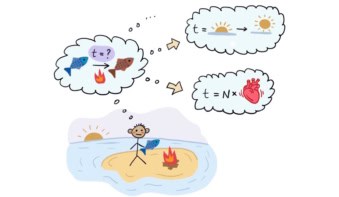The Cosmic Landscape: String Theory and the Illusion of Intelligent Design
Leonard Susskind
2005 Adult Books 416pp
$24.95hb

Theoretical physicists are as big a bunch of atheists as you would care to meet. So why are they always going on about God?
“God does not play dice,’’ declared Albert Einstein.
“We should know the mind of God,’’ wrote Stephen Hawking.
Not even the experimentalists are immune: the Nobel laureate Leon Lederman wrote a book called The God Particle.
The answer, it seems, is that their God is not a personal deity in the usual religious sense, but rather some cosmic intelligence responsible for creating the universe and designing the laws of nature. As Hawking put it, “You still have the question: why does the universe bother to exist? If you like, you can define God to be the answer to that question.”
Nevertheless, they are treading on dangerous ground. Nowadays, the words “intelligent” and “design” have acquired a more sinister meaning in the US when combined into the “intelligent design” movement. Its supporters seek to undermine Darwin’s theory of natural selection by claiming that the world is just too complex to have evolved naturally and must therefore be the work of an intelligent being. Intelligent design is creationism through the back door.
With his new book, Leonard Susskind – Felix Bloch professor of theoretical physics at Stanford University – has now decided to step into these waters. Susskind is one of the pioneers of string theory and a leading light in our attempts to understand the origin of the universe and the laws of nature. Like most of his fellow theorists, he is a card-carrying atheist. Nevertheless, in The Cosmic Landscape he expresses sympathy for the intelligent-design view when applied to physics and cosmology rather than biology.
Susskind believes that it is more than dumb luck that the universe is so accommodating to human beings. “Can science explain the extraordinary fact that the universe appears to be uncannily, nay, spectacularly, well designed for our own existence?” he asks.
But does this mean that the religious fundamentalists have won? Must we invoke the existence of a god to account for the gaps in our knowledge? Susskind’s answer is “no” on both counts. As you might have guessed from the book’s subtitle, he argues that while “the appearance of intelligent design is undeniable”, science can nevertheless explain it all. Phew! Thank God for that.
The key ingredient in Susskind’s thesis is the “landscape” – a term that he coined in 2003. To understand what the landscape is, we need to recall some things about superstring theory. This theory says that the fundamental building blocks of nature are not point-like elementary particles but tiny 1D strings that live in a universe with one time and nine space dimensions. Just like violin strings, these relativistic strings can vibrate, and each mode of vibration represents a different elementary particle.Most importantly, these stringy particles include gravitons, the hypothetical carriers of the gravitational force.
Indeed, superstrings satisfy one of the main requirements of a consistent theory of quantum gravity. They allow us to calculate the probability of transitions from one quantum state to another involving gravitons without encountering the infinities and anomalies that have plagued all previous attempts based on applying ordinary quantum field theory to Einstein’s general relativity.
Superstrings nevertheless subsume Einstein’s theory, which is recovered in the limit where the energy of the gravitons is sufficiently small. Moreover, the superstring equations allow solutions for which six of the nine dimensions are curled up to an unobservably small size. The theory is, in other words, compatible with our experience of a world with only three space dimensions (see “Superstrings” by Leonard Susskind Physics World November 2003 pp29-35).
Unfortunately, there are not one but five mathematically consistent superstring theories, each competing for the title of the theory of everything; clearly an embarrassment of riches. This problem is cured by M-theory, a unique, all-embracing theory that subsumes the five superstring theories by requiring 11 space-time dimensions and incorporating higher-dimensional extended objects called branes. Among the achievements of M-theory is the first microscopic explanation for the entropy of a black hole, first predicted in the 1970s by Hawking using macroscopic arguments.
The problem with M-theory is that although its equations may be unique, it has billions and billions of different solutions. (Susskind claims about 10500, but I would take issue with this: in 11D supergravity – the low-energy approximation to M-theory – the number of ways of curling up its extra dimensions is actually infinite.) Susskind’s landscape is just this space of possibilities – a schematic representation of all the possible environments permitted by theory.
Each possible environment has its own laws of physics, its own elementary particles and its own constants of nature. Even the number of space-time dimensions might be different. So what singles out our particular universe? For many years, physicists hoped that some selection principle would be discovered that would pick one valley in the landscape – and that that valley would be our universe. But as Susskind notes, this selection principle has proved to be a lot like the Loch Ness monster: it is often claimed to exist but no-one has ever seen it.
An alternative answer to what makes our universe so special might be the anthropic principle. As its supporters note, all it takes is a small change in Newton’s laws, or to the rules of atomic physics, and life would either be instantly extinguished or would never have formed. In other words, the anthropic principle says that the world is fine-tuned so that we can be here to observe it. Unfortunately, many physicists think the anthropic principle is uncomfortably close to intelligent design.
Nevertheless, no less a person than Nobel laureate and arch-atheist Steven Weinberg believes that one particular constant of nature – Einstein’s cosmological constant Λ – may be anthropically determined. The size of L has long been an enigma. Theoretically its most natural value would be unity in natural units, but anything bigger than 10-120 would be inconsistent with astronomical data – and a world record for the worst agreement between theory and experiment!
So Weinberg set out to see if any bigger value would prevent life. The answer, it turned out, did not have anything to do with molecular chemistry or the stability of the solar system. Weinberg found that if L were just an order of magnitude bigger than 10-120, no galaxies, stars or planets would have formed. His anthropic arguments not only provided a limit on L, they also give some idea of its expected value. In 1992 he wrote, “Thus if such a cosmological constant is confirmed by observation, it will be reasonable to infer that our own existence plays an important role in explaining why the universe is the way it is.” Even sceptics had to take notice, therefore, when recent astrophysical observations indicated that L is, in fact, non-zero and has just about the value Weinberg predicted.
To avoid any intelligent-design connotations, however, there is still one missing ingredient: the “multiverse” or, as Susskind likes to call it, the “megaverse”. According to a popular but still controversial version of “cosmic inflation”, due to Andre Linde and others, there is not just one Big Bang but a whole series of bubble universes that are continuously being created. If we combine this with M-theory, every kind of universe permitted by the landscape will eventually come into existence. This is called the “populated landscape”.
To avoid confusion, Susskind reminds us that the landscape is not a real place, just a list of possibilities. The pocket universes of the megaverse, on the other hand, are real places. Hence his slogan: “A landscape of possibilities populated by a megaverse of actualities.”
Susskind concludes that questions such as “why is a certain constant of nature one number rather than another?” may well be answered by “somewhere in the megaverse the constant equals this number: somewhere else it is that number. We live in one tiny pocket where the value of the constant is consistent with our kind of life. That’s it! That’s all. There is no other answer to the question”.
The anthropic principle is thus rendered respectable and intelligent design is just an illusion. The author’s stance is the same as that of Laplace when asked by Napoleon why his celestial mechanics had no mention of a creator: “Your highness, I have no need of this hypothesis.”
By the way, Susskind expresses the hope that the sentence “the appearance of intelligent design is undeniable’’ will not appear out of context on a religious Internet site. Fat chance!



